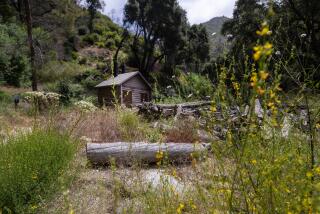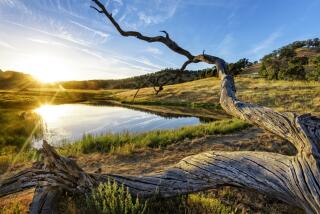Cabin Owners Face Day of Reckoning
A fight that has festered for decades is coming to a head in the dark woods of Sequoia National Park.
A community whose roots stretch back to the 1870s is struggling to hang on to rustic cabins that were handed down through families for generations to the people who today use them for summer vacations.
The private cabins were built on public land -- a contradiction that has been argued all the way to the U.S. Supreme Court and to Congress.
Now park officials want to reclaim the area as part of a long-term master plan for the national park.
The cabin owners and their supporters in Congress have fought back by introducing a bill that would give cabin-owning families the right to stay indefinitely.
“We’ve invested several lifetimes into these cabins,” said John Crowe, one of the owners. “Why should we have to leave?”
The 67 cabins in Mineral King Valley were part of a mining community in the late 19th century, but miners found the gold and silver too hard to extract. Instead, the cabins wound up in the hands of vacationing families looking to escape the searing summers of the Central Valley.
Ever since, the cabins have been passed down within the families, who have preserved the old lifestyle along with the wooden buildings. Built of rough-hewn lumber, most have no electricity or telephones and are illuminated by gas or kerosene lights. Some still have working wood stoves and outhouses.
Crowe, who was born in his family’s cabin, believes he and others should be able to stay in their cabins, in part because of all the work they have put into the community.
Throughout the generations, vacationing families have repaired roofs, fought forest fires and built a dam nearby to supply running water.
“It was a lot of work, but this place, this community, it’s worth it,” Crowe said.
The families nearly lost their community in the 1970s when the Disney company proposed building a ski resort there. The vacationers, among others, argued their case all the way to the U.S. Supreme Court, but it was a law passed by Congress that saved them.
Before Congress acted, Mineral King Valley had been part of the national forest, open to Disney’s development plans. The National Parks and Recreation Act of 1978 made it part of Sequoia National Park, blocking Disney’s proposal.
But the law that saved the cabins came with conditions: The permits were renewable only by current owners or their spouses, and would expire as they died.
The cabin owners now argue that park officials surprised them with that condition at the last minute, leaving them no choice but to accept.
“Some owners didn’t even hear about it until after. Then they were outraged,” Crowe said.
Park officials dispute that account, and former Rep. John Krebs, who proposed the 1978 law, said the terms were spelled out to the owners.
“Of course we talked to them before the law was passed,” Krebs said. “We held hearings.”
In any case, two new and opposing proposals are now driving the conflict toward possible resolution. On the side of the cabin owners, Rep. Devin Nunes (R-Tulare) proposed a bill last month that would let them stay.
On the other side, park officials recently unveiled a master plan for the national park, which includes the gradual return of the cabins and associated area for public use.
The cabin controversy is one small part of the 630-page master plan, which took six years to produce and addresses 394 other park issues, said park spokesman William Tweed.
But, as in years past, the cabins in Mineral King have provoked the most contention.
More to Read
Sign up for The Wild
We’ll help you find the best places to hike, bike and run, as well as the perfect silent spots for meditation and yoga.
You may occasionally receive promotional content from the Los Angeles Times.






